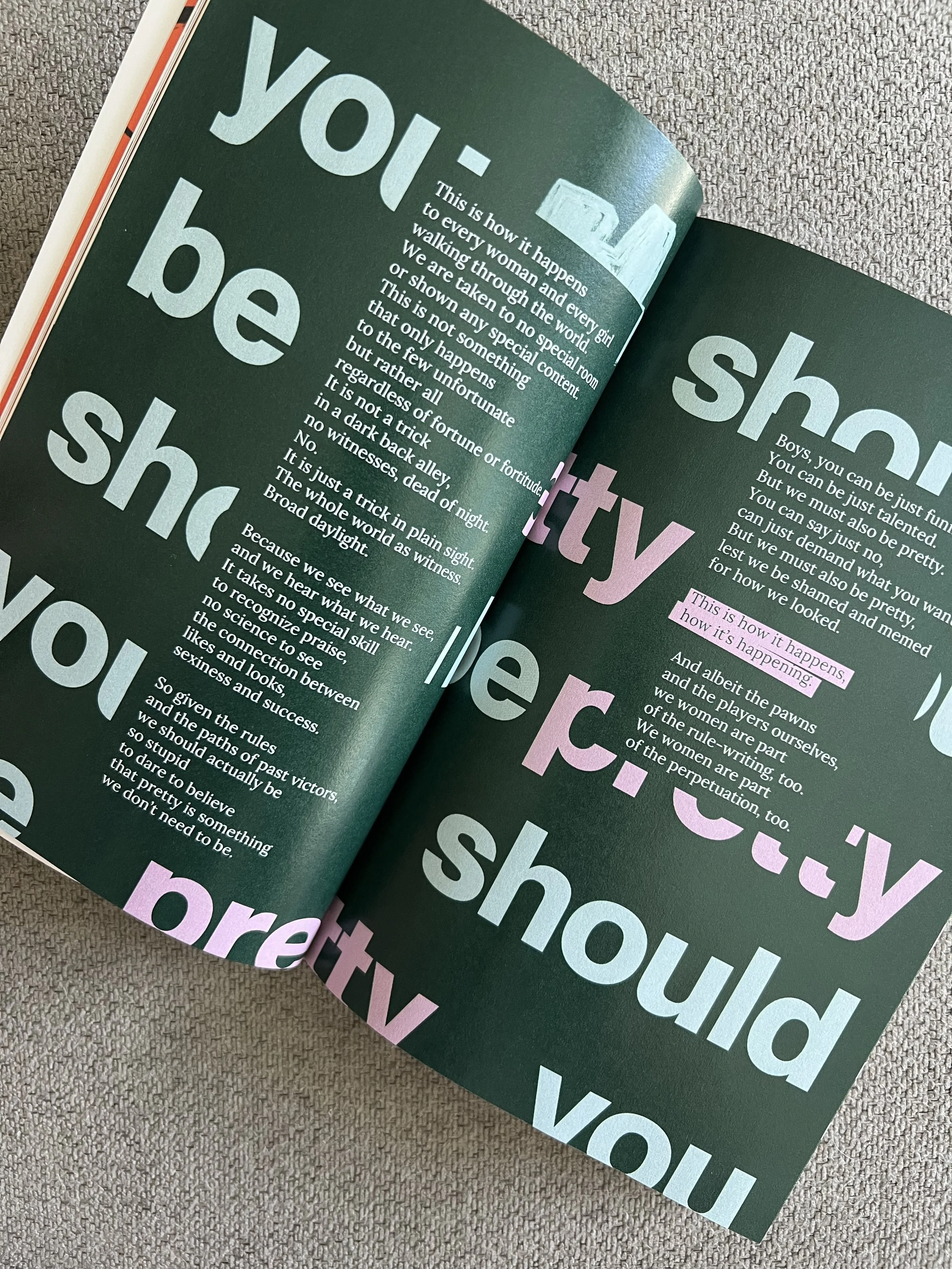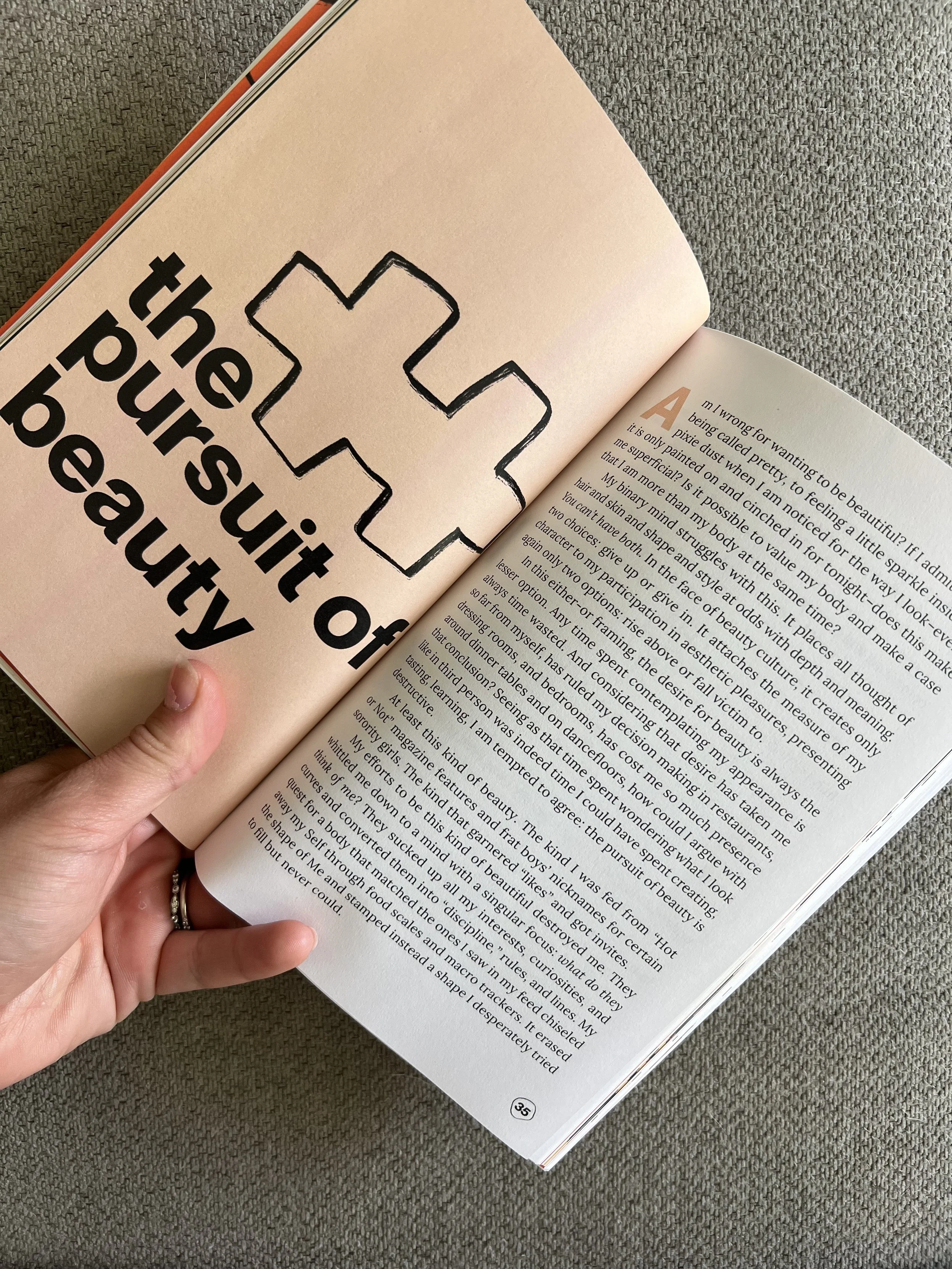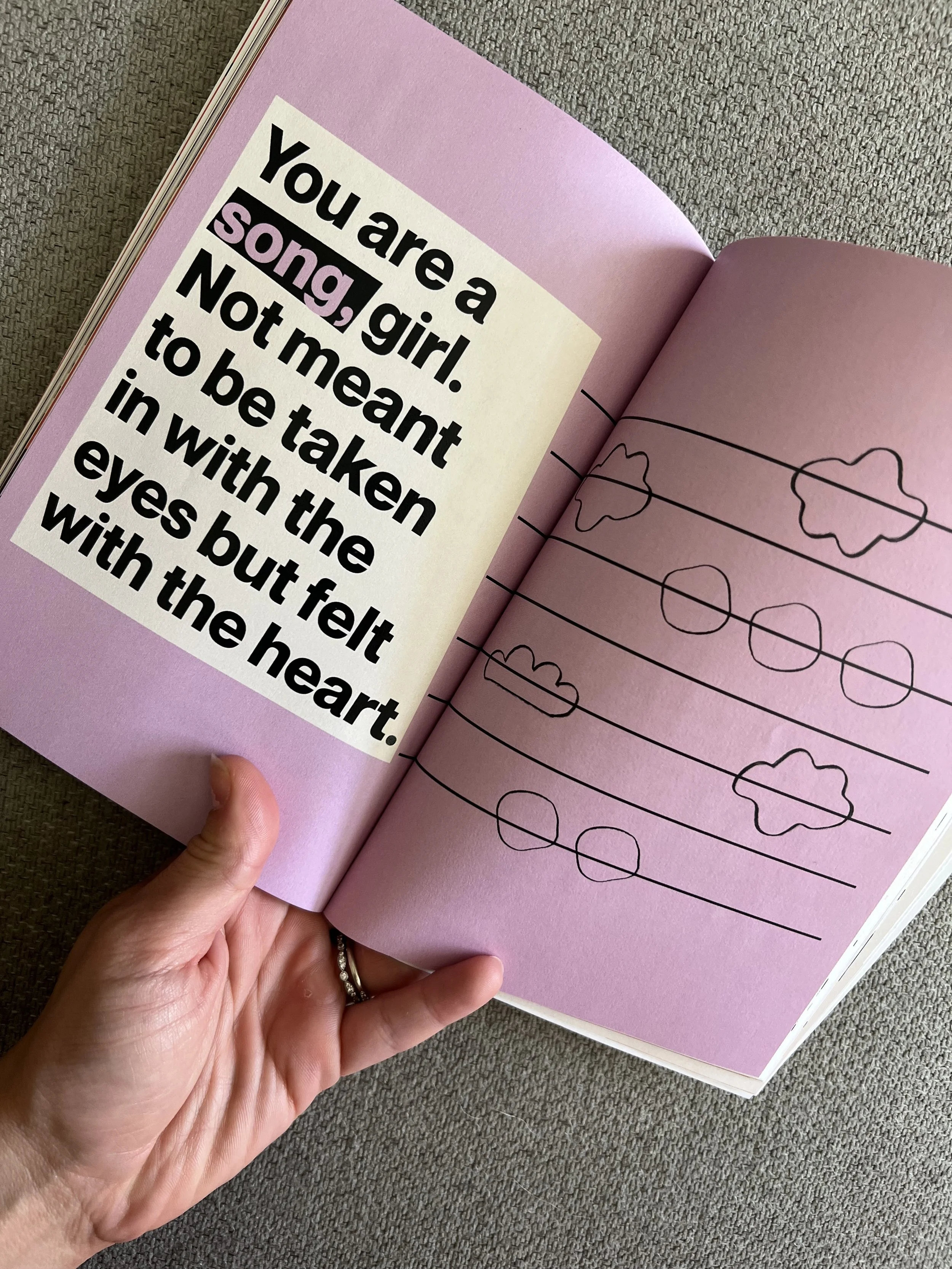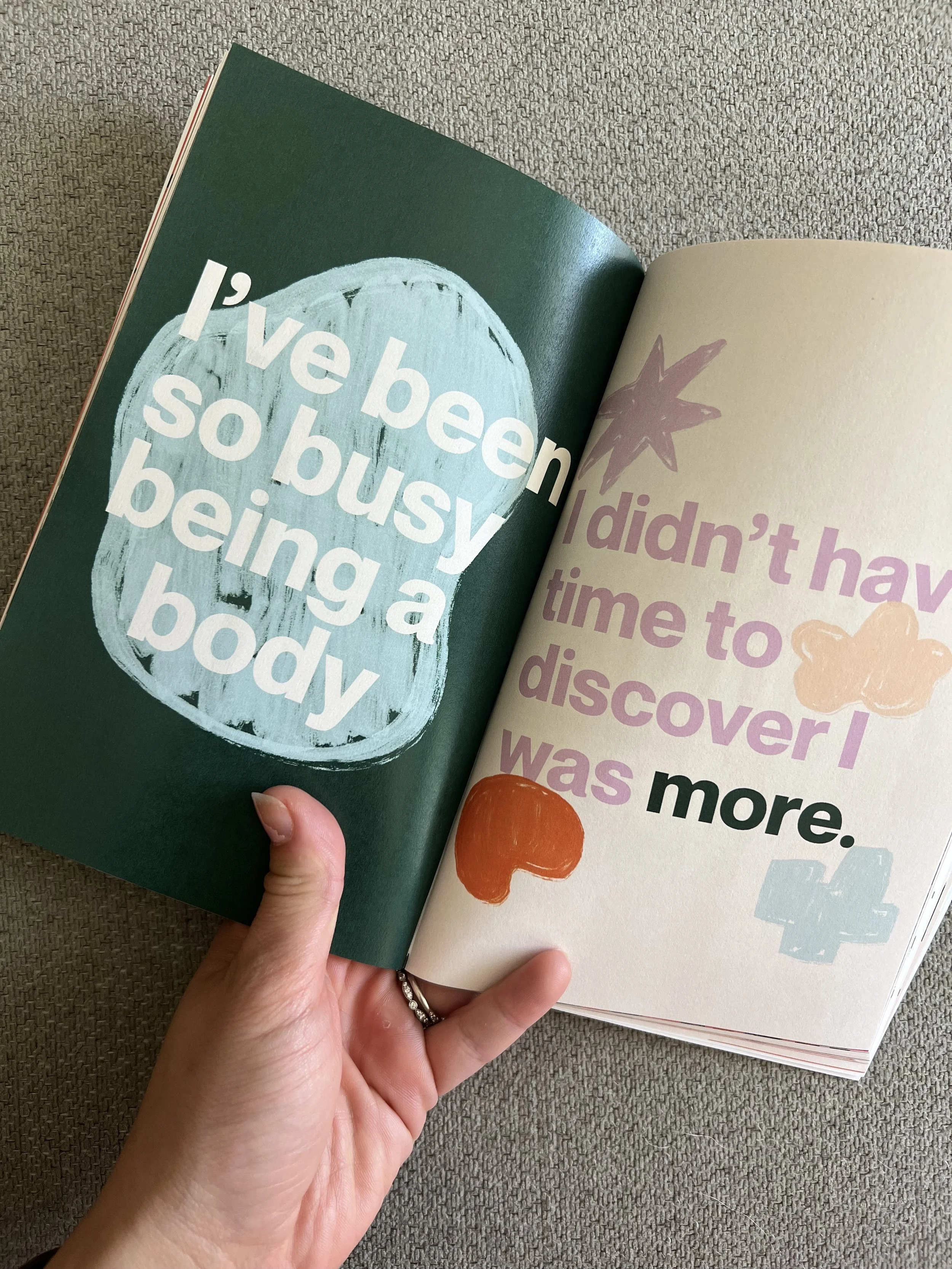Prologue
I am using a postage scale I found in Mom’s cabinet to weigh my food. This is how sick I am. I would die of shame if anyone walked in on me doing this, but the anxiety of the uncertainty is killing me already. How many ounces of meat is this? How many grams of berries? I need to know exactly how much I am eating so I can know in cold, hard numbers I am eating the perfect amount to have my perfect body.
I don’t travel with my food scale. That would be embarrassing! Just as embarrassing as if my friends I was day drinking with that time saw me on the treadmill an hour later genuinely believing I was cancelling out the calories I had just consumed. Or if anyone saw the note in my phone where I stored the nutrition information from restaurants I frequented. Or worse, the horrid self-timer photos of me in my sports bra and underwear in my bedroom, flexing for before-and-after progress pics.
I knew what people would think of me if they knew these things, and What They Think of Me used to matter deeply to me. My body image struggles were but a soul-sucking effort to control what others thought of me. If I could make my body match the bodies they said good things about, I could make them say good things about me, too. If they said good things about me, well, then, this would mean I was good, too, right?
This is why I weighed my lunch in secret on a postage scale, why I needed to know way in advance if we were going out to eat, why I sat on the beach on the brink of bliss but packed up my chair just in time to get a workout in before dinner. This is why I took so long to order that second drink I wanted while I was catching up with an old friend at the bar around the corner from our alma mater: the mental math of carbs and calories was taking me a while to work out. It’s why I was living my high school French class dreams abroad but thinking about how fat I looked in the pictures.
All of this: a collective effort to write their story of me, entirely at the expense of mine.
I can’t recall exactly when or why my fixation on What They Think of Me began. I can only assume it was late elementary to early middle school, the time our brains begin to understand this concept of social ladders and strata and connect the dots between how we are and where we rank. This discovery of the perception of me and my ability to alter it with things like my smile, my humor, my performance, my body took over the innate existence of me. The way I was as I came. Effortless and unobserved. Me without the thought of me.
At that time, the coming-of-age question, “Who am I?” intertwined with, “What do they think of me?” My answer to the second informed the first. This questioning was a wave of water continuously crashing on the shores of my tiny teenage consciousness, and I was porous and malleable. Being the cute, tiny girl at the top of the cheer pyramid, hearing them say I was pretty, having a date to every dance—all things hinging upon my appearance—filled me up and shaped my identity. Wondering who I was and if I was liked felt so big and so heavy that I took the first opportunity I saw to set it down and rest in the answers. Never mind they had come from someone else.
This was the beginning of staring into the big giant hole of “Who Am I?” and filling it with “What People Think of Me.” It might not have been smart, but it was easy. A straight-forward way to determine my worth: if what other people thought about me was good, so was what I thought about me.
Long before I had the capacity to understand what I was doing, I had hitched the wagon of my value to others’ perceptions of me and started my faithful, exhausting monitoring of all cues and signs of their approval of me (or lack thereof).
I used to think everyone but me outgrew this teenage hypervigilance. I used to shove masculine advice in the face of it in an effort to rid myself of it. After all, the boys seemed to be completely detached from the opinions of others.
Who cares what people think, fuck them!
I know now their explicit expression of “not giving a fuck” was just putty over drywall, the crude, patchy exterior the very evidence of the soft concern below. The boys cared, too. They were just not allowed to care and be masculine at the same time. Rising above granted their acceptance, but playing along granted mine. This I learned through noticing how different attitudes, different words, different behaviors each got me different friends, different boys, different party invitations.
This awareness of how others saw me and its subsequent effects was not just something unique to me that I never outgrew, though. The conversations I’ve had with with women as a coach, a sister, a friend, the observations I make about our behaviors in the world and our posts online, the rise in discussions about “boundaries” and the number of resources teaching women how to say “No”—these things let me know I am far from the only girl who outgrew my Bubblegum lip gloss but not my obsession with the perception of me.
I would see my body first and my life second for many, many years before doing so would take its toll and force me to confront what this was costing me: presence, joy, freedom. The perception of me would weigh more than the truth of me until the perspective I gained with time and age would slowly rearrange my values.
I know not everyone moves through the world with this same paranoia of what others think of them. I know not all women use their bodies as a proxy to give them the illusion of control over how they are perceived. This is just my story. These are just my experiences. My words do not represent all women everywhere, nor do they necessarily represent only women. This is just simply the only perspective I can write from, and mine is the only story I can tell.
If you find yourself in these pages, I’m sorry, but I’m glad you’re here. If you don’t see yourself, I’m also glad you’re here, because maybe you will see someone you know, someone you love, or someone you will meet one day soon. In any case, my hope for this book is the same: that by tracing my way through finding the shape of me, you, too, start to see and appreciate the shape of you.
the shape of you
The shape of You is not a shape at all.
It is not a pear or an apple or an hourglasses or any right-side-up or inverted geometric figure the makers of blue jeans and wedding gowns want to call it in efforts to convey our physicality for their made up rules of flattering angles and garments.
These are shapes, yes, but none is the shape of You.
The shape of You has no name, no label, there is nothing to which to compare it because there is nothing like it. It need not be named because it will never occur again, so we can just call it “You” and “Me,” “Her,” and “Him.”
There is nothing universally “flattering” for the shape of You because the shape of You is beyond flattery. To speak of flattering the shape of You is to speak of wrangling the planets or directing the sunset. The beauty in the shape of You is in its mere existence.
The beauty in the shape of You is not the kind we talk about most. There are two realms of beauty. In one realm there is beauty we take in through eyes. It’s angles, colors, patterns, shades, and shapes that can all be captured two dimensionally. This is the realm of social media and mirrors, dressing rooms and diets, backseats and bedrooms of lovers also unsure of and insecure about their own shapes. The shape of You is not of this realm, and when you try to see it there, that is why you cannot appreciate it.
There exists another realm where beauty is taken in through heart and experience. It’s the feelings you give and the impression you leave that can only be captured in emotions and electricity, a 4D unfolding of life no image or eye could ever hold. This is the realm of creativity and courage, connection and candor, vibrations and chemical reactions unseen and only felt. Like the birds who see in ultraviolet, in this realm our vision expands. When you consider the shape of You in this realm, its beauty is beyond question. To bother with such musings is unheard of. In this realm, your existence is itself, beauty.
The shape of You is rain, not a raindrop. The shape of You is light, not a bulb. The shape of You is love, joy, sometimes sadness. How can we draw lines around these things? The shape of You is home: felt, crafted and valued differently depending on the dweller.
To talk about your shape is to put edges around formless things, to make a noun what is a verb.
The shape of You is an ocean wave rolling in with a new offering of shells to collect. It’s a glowing ball of gas dancing across the black sky that only those who are looking will see. It’s rolling the windows down on a spring afternoon and smelling fresh cut grass while that one song plays, a nostalgia that hurts so good.
Some things just happen. Some things cannot be measured. That is the shape of You.
And so when you feel dissatisfied with the way you are shaped, with your edges and your lines, where your skin ends and the world begins, I hope you remember that this shape is not the shape of You.
The shape of You is something to be felt with the heart not the hands, witnessed with the part of us that connects us to each other deep down inside, not just with our eyes.Trying to flatter the shape of You is as foreign as trying to make better the way the first day of summer feels when you’re seven. No such thing. No such way. Some things just happen, some things cannot be measured.
You are shapeless. Formless. Edgeless. Lineless. You are energy, movement, essence, color. You are being. You are living. You are experiencing. That is the shape of you.
trying a new thing
I am trying this new thing where I look at a woman, and I stop myself from assessing how pretty she is or how well she’s dressed or what kind of body she has, or whether or not her arms are defined or her legs are bigger than mine, or if she dyes her hair or plumps her lips. I just say to myself, I wonder how many people love her and what magic she brings to this world.
This new thing makes me want to say “hi” to every woman I see. I want to find out about who she is and what she’s also doing in TJ Maxx on a Tuesday morning. Maybe she needs a new purse, too, or got a gift card for her birthday, and she’s finally treating herself. Maybe she got some really hard news yesterday and needs a little retail therapy. Maybe she’s in a phase of her life where she’s liking herself for the first time in a while. Maybe we’re not all that much different, after all.
This new thing has magnified and intensified my view of women, opened up a whole new spectrum of visible light and colors. It’s as if the world was black and white before, and now I have on glasses that show me all the color I’ve been missing. As if the world was meant to be seen in 3D, but I was trying to take it in without 3D glasses.
Where there used to be just a person with a body and clothes and skin and hair, now there is someone’s best friend with a contagious laugh and the best advice and a down-for-anything personality.
There is someone’s mom with the perfect length nails for running through your hair when your head is in her lap and a house that smells like magnolia and wood.
There is someone’s daughter with grief in her heart from a childhood loss but a renewed perspective on life that helps her be more present and compassionate.
Where there used to be a size, there is a life. Where there used to be a judgement, there is a connection.
This new thing has made me think about my sisters, all scattered across the country in their respective cities living their respective lives. Doctoring, counseling, rescuing, mothering—doing this deep and loving work of the world and yet also being victims of visual reduction from other women just like us when they are out getting gas or buying wine or Chinese takeout.
It feels like emotional heartburn to imagine them being judged so critically, these girls with whom I am not only genetically connected but soulfully. It burns when I am forced to swallow the truth that I, too, have judged someone else’s sister out in the wild. I accept it as fact I have been judged the same way by someone else, too.
This new thing also makes me think of my mama. How dare anyone say anything critical about the woman who made us her entire life, whose identity became literally hinged on our existence: Mom. I think of the way I see her: enormous in heart, her love taking up the entire space she is in and even the places she isn’t now that we have left her nest.
I think of the way she sees herself: enormous in body. The way she thinks others see her: old. Frumpy. Wrinkly. It makes me want to shout at anyone who ever passed such judgement on her, although I have done the same to women her age until the appearance of their grandchild at their side reminds me they are so, so very much more than a body under the spell of gravity.
A grandma is a mom who still has more love to give. After everything my mom gave me and still gives me, I cannot fathom how there is anything left. And yet someone saw her and thought her hair wasn’t doing her any favors.
Someone saw me and thought my legs were too big. My face was too pimply. My outfit wasn’t flattering. My stomach wasn’t flat enough. My arms were jiggly. And yet, I know I am so much more than those things.
A surprising thing has happened since I started trying this new thing, where I see a woman for who she is instead of how she looks. It has not only changed the way I see others, it is slowly changing the way I see myself. Not to be dramatic, but I’m pretty sure this is the secret to everything. I’m pretty sure we will break the whole system if we start to see each other, really see each other.
I’m pretty sure the whole thing collapses once we stop holding it up.













